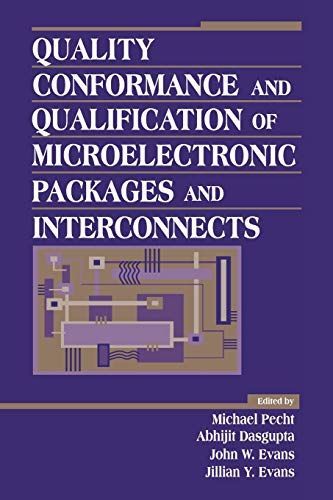
Quality Conformance and Qualification of Microelectronic Packages and Interconnects
All packaging engineers and technologists who want to ensure thatthey give their customers the highest quality, most cost-effectiveproducts should know that the paradigm has shifted. It has shiftedaway from the MIL-STDs and other government standards and testprocedures that don't cost-effectively address potential failuremechanisms or the manufacturing processes of the product. It hasshifted decisively towards tackling the root causes of failure andthe appropriate implementation of cost-effective process controls,qualityscreens, and tests. This book's groundbreaking, science-based approach to developingqualification and quality assurance programs helps engineers reacha new level of reliability in today's high-performancemicroelectronics. It does this with powerful... * Techniques for identifying and modeling failure mechanismsearlier in the design cycle, breaking the need to rely on fielddata * Physics-of-failure product reliability assessment methods thatcan be proactively implemented throughout the design andmanufacture of the product * Process controls that decrease variabilities in the end productand reduce end-of-line screening and testing A wide range of microelectronic package and interconnectconfigurations for both single-and multi-chip modules is examined,including chip and wire-bonds, tape-automated (TAB), flip-TAB,flip-chip bonds, high-density interconnects, chip-on-board designs(COB), MCM, 3-D stack, and many more. The remaining packageelements, such as die attachment, case and lid, leads, and lid andlead seals are also discussed in detail. The product of a distinguished team of authors and editors, thisbook's guidelines for avoiding potential high-risk manufacturingand qualification problems, as well as for implementing ongoingquality assurance, are sure to prove invaluable to both studentsand practicing professionals. For the professional engineer involved in the design andmanufacture of products containing electronic components, here is acomprehensive handbook to the theory and methods surrounding theassembly of microelectronic and electronic components. The bookfocuses on computers and consumer electronic products with internalsubsystems that reflect mechanical design constraints, costlimitations, and aesthetic and ergonomic concerns. Taking a totalsystem approach to packaging, the book systematically examines:basic chip and computer architecture; design and layout;interassembly and interconnections; cooling scheme; materialsselection, including ceramics, glasses, and metals; stress,vibration, and acoustics; and manufacturing and assemblytechnology. 1994 (0-471-53299-1) 800 pp. INTEGRATED CIRCUIT, HYBRID, AND MULTICHIP MODULE PACKAGE DESIGNGUIDELINES: A Focus on Reliability --Michael Pecht This comprehensive guide features a uniquely organized time-phasedapproach to design, development, qualification, manufacture, andin-service management. It provides step-by-step instructions on howto define realistic system requirements, define the system usageenvironment, identify potential failure modes, characterizematerials and processes by the key control label factors, and useexperiment, step-stress, and accelerated methods to ensure optimumdesign before production begins. Topics covered include: detaileddesign guidelines for substrate...wire and wire, tape automated,and flip-chip bonding...element attachment and case, lead, lead andlid seals--incorporating dimensional and geometric configurationsof package elements, manufacturing and assembly conditions,materials selection, and loading conditions. 1993 (0-471-59446-6)454 pp.